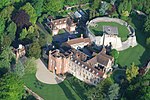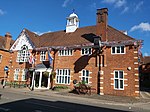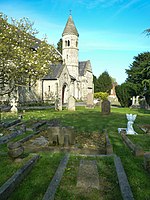Farnham () is a market town and civil parish in Surrey, England, around 36 miles (58 km) southwest of London. It is in the Borough of Waverley, close to the county border with Hampshire. The town is on the north branch of the River Wey, a tributary of the Thames, and is at the western end of the North Downs. The civil parish, which includes the villages of Badshot Lea, Hale and Wrecclesham, covers 14.1 sq mi (37 km2) and had a population of 39,488 in 2011.Among the prehistoric objects from the area is a woolly mammoth tusk, excavated in Badshot Lea at the start of the 21st century. The earliest evidence of human activity is from the Neolithic and, during the Roman period, tile making took place close to the town centre. The name "Farnham" is of Saxon origin and is generally agreed to mean "meadow where ferns grow". From at least 803, the settlement was under the control of the Bishops of Winchester and the castle was built as a residence for Bishop Henry de Blois in 1138. Henry VIII is thought to have spent part of his childhood under the care of Bishop Richard Foxe and is known to have lived at Farnham Castle when he was 16.
In the late medieval period, the primary local industry was the production of kersey, a coarse, woollen cloth. In the early modern period, the town's weekly corn market was said to the second largest in England after London. Between 1600 and the 1970s, the area was a centre for growing hops and for the brewing industry. The town began to expand in the early Victorian period, stimulated in part by the opening of the railway in 1849 and the arrival of the army in nearby Aldershot in 1855. Farnham became an Urban District in 1894, but under the Local Government Act 1972, its status was reduced to a civil parish with a town council.
The Farnham area has long been associated with the creative arts and with pottery making in particular. One of four campuses of the University for the Creative Arts is to the west of the centre and there are numerous works of public art on display in the town. Notable buildings in the civil parish include the ruins of Waverley Abbey and the 18th century Willmer House, now the location of the Museum of Farnham. Politician William Cobbett and writer George Sturt were both born in Farnham, as was Maud Gonne, the Irish republican suffragette. More recent residents have included the watercolour artist, William Herbert Allen, the Formula One driver, Mike Hawthorn, the England cricketer, Graham Thorpe, and the England rugby union captain, Jonny Wilkinson.










